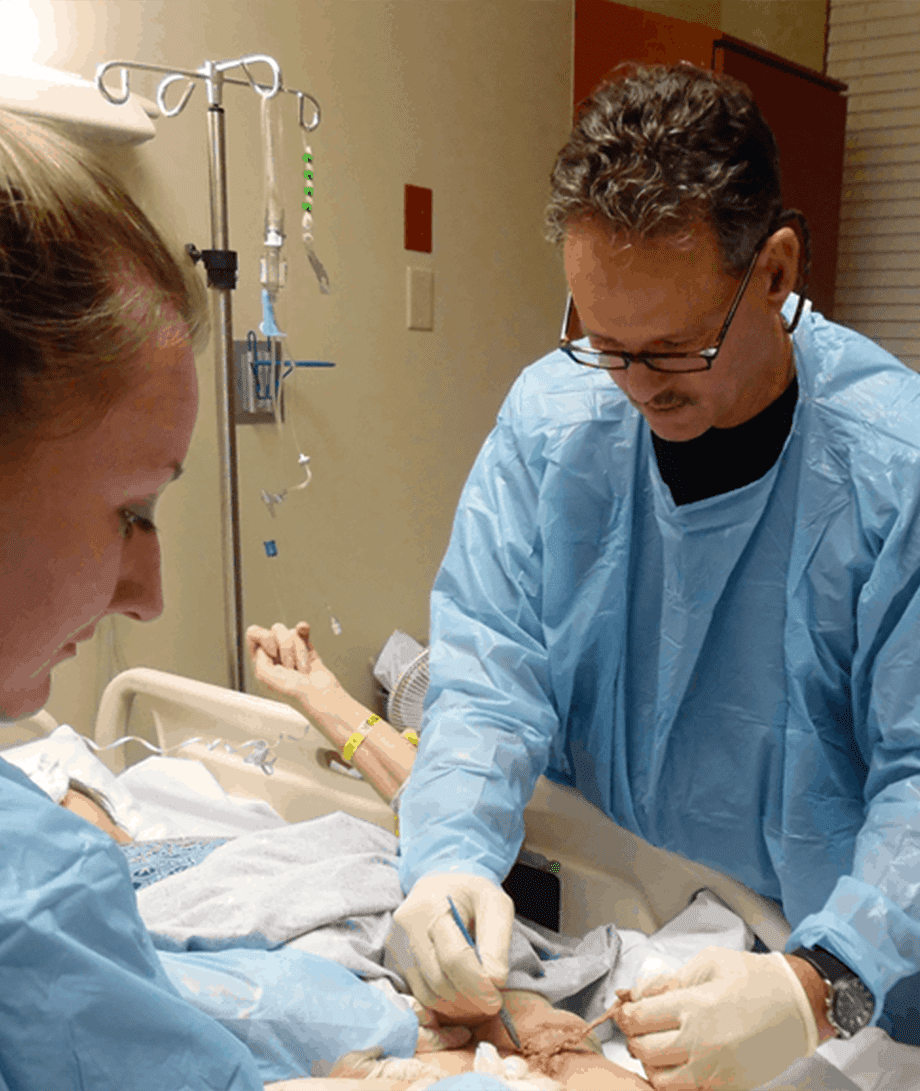What Causes Diabetic Foot Ulcers
Diabetic foot ulcers typically develop due to a combination of factors, including neuropathy (nerve damage), poor blood circulation, and repeated pressure or trauma to the feet.
Symptoms of Diabetic Foot Ulcers
Recognizing the symptoms of diabetic foot ulcers is vital for prompt intervention.
Symptoms of Diabetic Foot Ulcers:
Recognizing the symptoms of diabetic foot ulcers is vital for prompt intervention.
- Redness
- Swelling
- Warmth in the foot
- Drainage of pus or other fluids from the wound
- In some cases, painlessness due to neuropathy
Treatment for Diabetic Foot Ulcers
Our Approach to Diabetic Ulcer Care
Comprehensive Assessment: Our experienced doctors will conduct a thorough assessment of your condition, considering factors like wound size, infection risk, and your overall health.
Personalized Treatment Plans: We believe in personalized care. Your treatment plan will be tailored to your unique needs, ensuring the best possible outcome.
Advanced Wound Care: We utilize the latest in wound care techniques and technology to promote faster healing and reduce the risk of complications.
Rapid Response Follow-Up: If you notice the foot ulcers are not improving, call our team immediately for at-home care.
Patient Education: Understanding how to manage your condition is important to prevent ulcers from worsening. We provide you with the knowledge and tools to participate actively in your healing journey.
Rapid Response: Homebound Care Service Diabetic Foot Ulcers
When seeking at-home care for a person with diabetes and foot ulcers, you should monitor the wound and ensure it is healing. With proper medication and wound care, diabetic foot ulcers will go away with time. Still, if lifestyle changes are not made, you may need more advanced treatment from a professional, mainly if you have limited movement.
Reasons we treat diabetic foot ulcers at home:
- Homebound patients with diabetic ulcers that don’t show signs of improvement within a few days.
- Signs of infection include increased redness, swelling, warmth, or pus.
- The ulcer is deep or has exposed tendons, bones, or joints.
- The patient is experiencing fever, chills, or unexplained pain.
- History of complications like cellulitis or osteomyelitis requiring more advanced treatment and monitoring.
How to Prevent Diabetic Foot Ulcers
If you have diabetes, it’s important to follow your treatment plan and talk to your doctor about any pain you have. There are a few things you can do to prevent diabetic foot ulcers from getting worse, including:
- Maintain stable blood sugar levels through diet, medication, and regular monitoring.
- Conduct daily foot inspections to detect any changes or injuries.
- Wear comfortable, well-fitting shoes that reduce pressure on the feet.
- Maintain diligent foot hygiene to prevent dry skin and cracks.
Ways to Manage Diabetic Foot Ulcers at Home
You should always talk to a doctor if you suspect foot ulcers due to diabetes. You don’t want to wait to get a medical opinion, as the risks are too great for people with diabetes.
For mild cases, wound care at home can be effective:
- Gently clean the wound with mild soap and warm water.
- Apply an antibiotic ointment and cover the wound with a sterile bandage.
- Offload pressure from the affected area using specialized shoe inserts or offloading devices.
- Keep the site clean and dry, changing dressings regularly.
Our doctors visit diabetic patients at home to swiftly administer comprehensive care where patients are most comfortable. The infrastructure of our practice is built to support mobile medicine. We actively curate a network of high-performing groups and individuals, including home and personal care agencies, care facilities, and community resources.
Avoid Complications of Untreated Foot Ulcers
We look after diabetic patients with the highest quality of care. We know that untreated diabetic foot ulcers can lead to severe complications, including:
- Gently clean the wound with mild soap and warm water.
- Apply an antibiotic ointment and cover the wound with a sterile bandage.
- Offload pressure from the affected area using specialized shoe inserts or offloading devices.
- Keep the site clean and dry, changing dressings regularly.
When facing issues like diabetic neuropathic pain, it’s imperative to seek an assessment right away. If you are feeling intense pain, fever, chills, fainting, or other signs of infection, you should seek emergency medical treatment.
Frequently Asked Questions
Testimonials

Why Get Treatment for Diabetic Foot Ulcers
If you’re not sure if the wound or pain in your foot is due to diabetes, you should still have your foot evaluated by a doctor, especially if the wound or pain doesn’t get better in a few days.
Knowing when to manage diabetic foot ulcers at home and when to seek medical attention is important for overall quality of life if you have diabetes. Regular foot inspections, diabetes management, and timely intervention can prevent complications and promote healing.
Freedom Health and Wellness brings the doctors to you with mobile medicine services and care. We work with a network of home and personal care agencies, care facilities, and community resources to deliver at-home care from excellent providers.
If you or someone you know is dealing with diabetic foot ulcers and cannot leave the house, contact Freedom Health and Wellness to inquire about at-home care.




